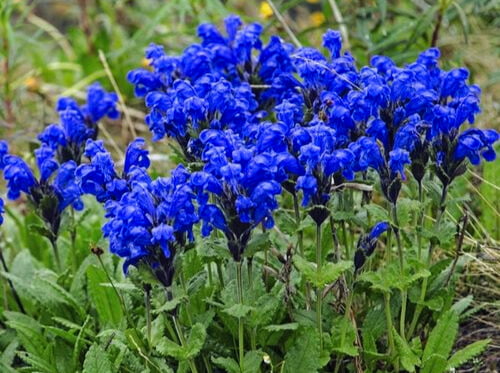
Choosing the Right Dracocephalum Species
When selecting the Dracocephalum species to grow in your garden, it’s important to consider your climate, soil type, and personal preferences. Let’s take a closer look at some popular varieties:
1. Dracocephalum argunense (Argun Dragonhead)
Argun Dragonhead is known for its enchanting blue-violet flowers that resemble miniature dragon heads. This variety thrives in well-draining soil and prefers full sunlight. It’s an excellent choice if you’re looking to add a vibrant splash of color to your garden. Additionally, its resilience makes it suitable for both novice and experienced gardeners.
2. Dracocephalum moldavica (Moldavian Dragonhead)
Moldavian Dragonhead is a favorite among herbal enthusiasts for its fragrant leaves and lovely lavender-colored blooms. This variety not only adds visual appeal to your garden but also fills the air with a delightful aroma. When planting Moldavian Dragonhead, choose a spot with well-drained, slightly acidic to neutral soil.
3. Dracocephalum ruyschiana (Ruysch’s Dragonhead)
With its pinkish-purple flowers and finely textured foliage, Ruysch’s Dragonhead is an attractive addition to any garden. This variety is often valued for its ornamental qualities. It’s well-suited for those seeking to create a visually captivating garden space. Like other Dracocephalum species, it thrives in well-draining soil and benefits from plenty of sunlight.
Planting Dracocephalum: Step by Step
Now that you’ve chosen the Dracocephalum species that best suits your garden, let’s delve into the planting process in more detail.
1. Selecting the Right Location
For optimal growth, ensure your chosen spot receives at least six hours of sunlight per day. Dracocephalum is a sun-loving herb, and providing it with adequate light is essential for robust development.
2. Preparing the Soil
Before planting, it’s advisable to prepare the soil by incorporating organic matter such as compost. This enriches the soil with nutrients and improves its drainage, promoting healthy root development. Aim for slightly acidic to neutral soil conditions, as this is ideal for Dracocephalum.
3. Planting Seeds or Seedlings
You have two options for starting your Dracocephalum garden: planting seeds indoors or transplanting young seedlings directly into the garden. If starting from seeds, sow them indoors a few weeks before the last frost date in your region. Transplant seedlings or place them in the garden bed once they are well-established, spacing them about 12 inches apart to allow room for growth.
4. Watering and Care
Dracocephalum appreciates consistent moisture but does not tolerate waterlogged soil. Water the plants in the morning to allow foliage to dry during the day, reducing the risk of fungal diseases. Regularly check for weeds and remove them to prevent competition for nutrients.
The Versatility of Dracocephalum
1. Culinary Delights
One of the delightful aspects of cultivating Dracocephalum is its culinary potential. The leaves of many Dracocephalum species are edible and can be used to enhance the flavor of various dishes. Add fresh dragonhead leaves to salads, use them as a unique garnish, or steep them to create flavorful herbal teas. The possibilities are as diverse as the herb itself.
2. Medicinal Marvels
Throughout history, Dracocephalum has been prized for its potential medicinal properties. It’s believed to possess anti-inflammatory and antioxidant qualities, making it a valuable herb for traditional remedies. Whether used in teas, tinctures, or as a topical treatment, Dracocephalum’s therapeutic potential is worth exploring.
3. Beneficial for Pollinators
Gardening enthusiasts will also appreciate Dracocephalum for its ability to attract beneficial pollinators like bees and butterflies. The vibrant blooms of dragonhead serve as a nectar source, contributing to the well-being of these essential creatures. By including Dracocephalum in your garden, you can play a role in supporting local biodiversity.
Conclusion
In conclusion, Dracocephalum is a remarkable herb that offers a multitude of benefits to gardeners and herbal enthusiasts alike. From its captivating blooms to its culinary and medicinal uses, this herb has earned its place in gardens around the world. As you embark on your journey to cultivate Dracocephalum, remember to choose the right species for your needs, provide proper care, and enjoy the rewards of nurturing this versatile and enchanting plant.
FAQs
1. Is Dracocephalum suitable for container gardening?
Absolutely! Many Dracocephalum species can thrive in containers, provided they receive adequate sunlight and well-draining soil.
2. How can I preserve Dracocephalum leaves for culinary use?
To preserve the flavor of dragonhead leaves, consider drying them and storing them in an airtight container. Alternatively, you can freeze them in ice cube trays with water for later use.
3. Are there any known side effects or precautions when using Dracocephalum for medicinal purposes?
While Dracocephalum is generally considered safe, it’s advisable to consult with a healthcare professional before using it for specific health concerns, especially if you are pregnant, nursing, or taking medication.
4. Can I use Dracocephalum as a companion plant in my vegetable garden?
Yes, planting Dracocephalum alongside your vegetables can help attract pollinators and deter certain pests, making it a beneficial companion plant.
5. When is the best time to harvest Dracocephalum for its vibrant blooms?
To enjoy the full beauty of Dracocephalum’s blooms, harvest the flowers when they are in full bloom, typically in the spring or summer, depending on the species and your location.